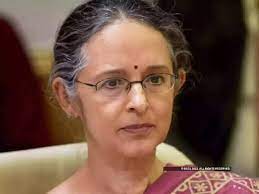New Delhi, Mar 12: Inflation is expected to come down over the year, RBI Monetary Policy Committee (MPC) member Ashima Goyal said on Sunday, asserting that the government’s supply-side action coordinated with a flexible inflation-targeting regime has kept the rate of price rise lower than that in other countries.
Goyal said that India has successfully dealt with ‘pluri-shocks’ over the past three years, showing considerable resilience.
“Inflation rates are expected to come down over the year.
“Government supply-side action coordinated with a flexible inflation targeting regime has kept Indian inflation rates lower than other countries and our own past averages even in this period of major adverse external supply shocks,” she told PTI in a telephonic interview.
She was asked whether high inflation become the norm in India.
“Since nominal policy rates rise with inflation to maintain an expected real positive rate under inflation targeting this prevents demand over-heating and anchors inflation expectations,” she noted.
Goyal said policy rates had been cut steeply during the pandemic, so they had to be raised fast after recovery was established.
“But policy rates must not rise too much at present because of slowing external demand. Domestic demand must be allowed to compensate,” she emphasised.
According to Goyal, as long as the expected future real policy rate does not rise much above unity, RBI is not over-tightening.
The Reserve Bank of India (RBI) has raised its benchmark repo rate by 250 basis points since May last year with expectations of another 25 basis points hike to 6.75 per cent in April before hitting pause until year-end.
The RBI lowered the consumer price inflation (CPI) forecast to 6.5 per cent for the current fiscal from 6.7 per cent. India’s retail inflation in January was 6.52 per cent.
To a question on what would be the likely impact of hot weather on wheat crop and food inflation, Goyal said weather patterns have become erratic, so it is necessary to build resilience in agriculture –for example, through more diverse cropping patterns and planting hardier crops.
That the winter vegetable crop was excellent despite protracted rains, suggests this may already be happening, she opined.
Noting that international wheat prices have also fallen, Goyal said, “So import, use of buffer stocks etc are part of many tools available to manage any potential food inflation.”
Replying to a question on India’s current macroeconomic situation, she said the country has successfully dealt with ‘pluri-shocks’ over the past three years, showing considerable resilience.
“The four principles that worked for India are BCCR: balance, countercyclical smoothing, coordination and reform,” she opined.
Goyal said the key to India’s outperformance was continual structural reforms that balanced supply and demand side support as appropriate, countercyclical policies that smoothed external shocks and good coordination between monetary and fiscal policies.
“As long as such policy support continues, India will be able to overcome the macroeconomic and growth risks facing it.
“Risks continue because of a potential global slowdown affecting manufacturing exports and persistent geo-political issues,” she noted.
Asia’s third-largest economy recorded year-on-year growth of 4.4 per cent in October-December, down from 11.2 per cent a year back and 6.3 per cent in the preceding quarter.
The finance ministry’s Economic Survey has projected economic growth to be 6.5 per cent in the 2023-24 fiscal beginning April 2023, while the RBI has projected India’s economic growth to slow down to 6.4 per cent in FY24 from 7 per cent in the current fiscal.
Asked whether the government is on track of fiscal consolidation as per the Fiscal Responsibility and Budget Management (FRBM) Act, Goyal pointed out that to reduce debt it is important to have both a primary surplus and growth rates that exceed real interest rates.
While recent budgets have credibly moved towards reducing deficits, Goyal said more emphasis on public investment will reduce revenue and primary deficits.
Noting that higher GDP growth reduces deficit and debt ratios as the denominator is higher and tax revenue buoyancy rises, she said India’s debt GDP ratio has already fallen from a peak of about 90 in 2020-21 to the mid-eighties in 22-23.
Commenting on the Union Budget for FY2023-24, Goyal said the biggest takeaway is the credible small steps taken towards fiscal consolidation even as better composition of expenditure helps maintain adequate stimulus.
She suggested that more strengthening of institutions and incentives is required to increase state capex and local public service delivery, which is lagging. Institutions make more policy continuity and stability feasible.
The RBI has been tasked to ensure retail inflation remains at 4 per cent with a margin of 2 per cent on either side. (PTI)
Trending Now
E-Paper


